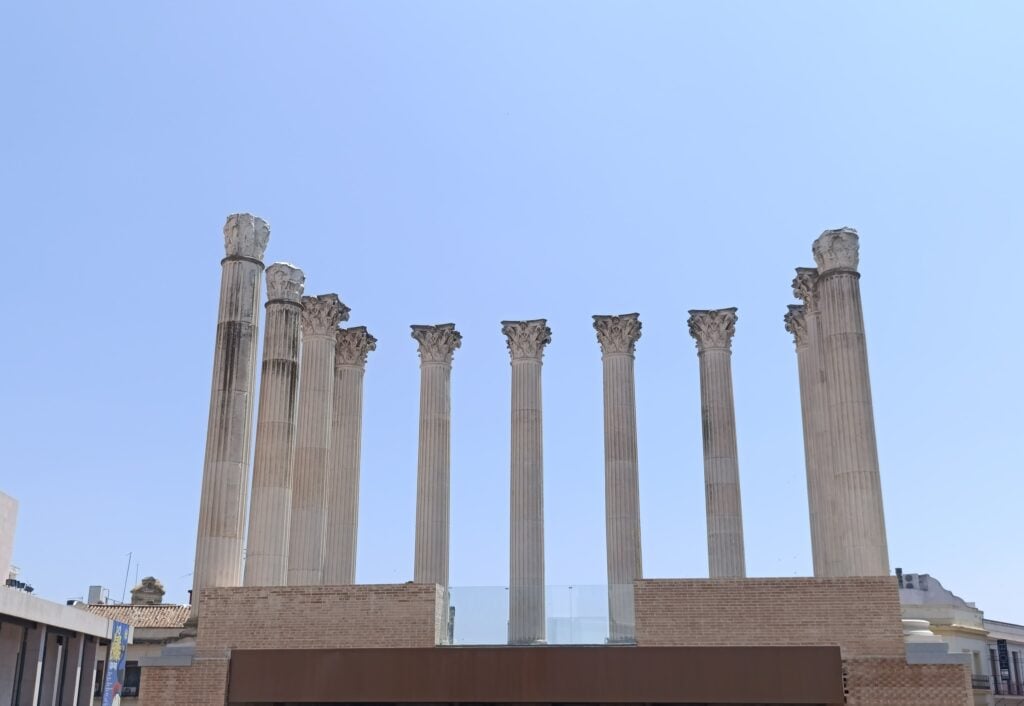
IF you know central Córdoba, you’ll likely recognise the soaring Corinthian columns that stretch nearly 40 feet into the deep Andalusian sky.
These dramatic remains belong to the Roman Temple of Córdoba, partially reconstructed during the 1960s in what is now often called a “botched job.” Yet, after decades of setbacks and delays, the monument has finally reopened to the public.
Since June 19, both locals and visitors have been able to ascend and walk among the towering columns, appreciating their ornate capitals up close and taking in a newly accessible view of the city. Most exciting of all, we can gain a better sense of what this temple to imperial worship—originally built in the first century AD—may once have looked like.
Mayor José María Bellido welcomed the completion of this long-overdue phase of restoration and the long-awaited reopening. It marks the end of a saga spanning over ten years, during which failed contracts and delays pushed back the originally scheduled 2015 opening.
Speaking from the temple’s portico—where ancient priests once stood to offer sacrifices while the public gathered on a lower terrace—the mayor announced the construction of a platform that now guides visitors, via ramps and stairs, into the heart of the monument. From this vantage point, visitors can see the foundations of the “naos,” the temple’s inner sanctuary, as well as the remains of the altar used for offerings.
This phase of the project, funded with €750,000 from European Next Generation funds, will now be managed by the City Council’s Department of Culture, in collaboration with the specialist company Incentifor.
For the first three months, guided tours will be offered twice daily from Monday to Friday, at 10:30 a.m. and 12:00 p.m., and three times a day on weekends and public holidays, at 10:00 a.m., 11:00 a.m., and 12:00 noon. Each tour is limited to thirty participants and can be reserved at visitastemploromano.incentifor.com.
From September onward, the City Council plans to launch a joint tender for managing ticketing and reservations not only for the Roman Temple but also for other key heritage sites, including the Patios de Córdoba Interpretation Centre on Calle Trueque, the Puerta Gallegos Mausoleums, and the Puerta del Puente.
READ MORE:
While this reopening marks a major milestone, it’s only the beginning. The City Council is already planning the next phase: a dedicated interpretation centre that will give visitors deeper insight into the temple and its various architectural and ceremonial components. “We’ll need to get used to regular upkeep of the Roman Temple,” the mayor noted, pointing out that this open-air site will require ongoing maintenance due to natural vegetation growth and exposure.
The reconstruction led by Félix Hernández in the 1960s—using a now-outlawed method known as anastylosis—was irreversible. As such, the temple can no longer be considered a traditional archaeological site. Municipal archaeologist Juan Murillo explained that after extensive study and debate, a decision was made to retain Hernández’s controversial structure, which is now part of the temple’s official designation as a Site of Cultural Interest.
Soon, visitors will be able to begin their tour from Calle Claudio Marcelo, entering behind the portico into the colonnaded area, which now stands atop a large brick platform. Inside this structure are archaeological remains, especially capitals, and further down—accessible by stairs—additional ancient finds.
But the most striking moment awaits at the top of a newly constructed stairway, which leads to a previously inaccessible area: the very heart of the Roman Temple, sitting between its monumental columns.
Click here to read more La Cultura News from The Olive Press.






